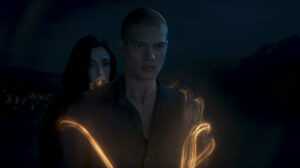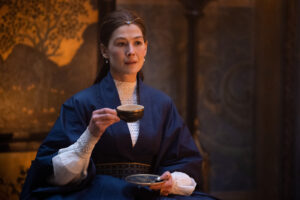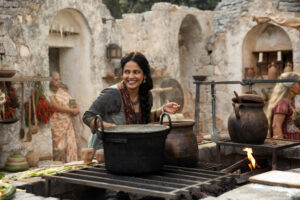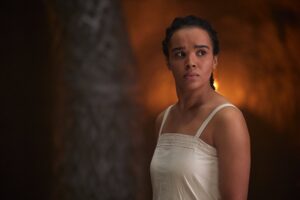MAJOR SPOILERS FOR THE WHEEL OF TIME SEASON TWO, EPISODES 1 – 6, AND BOOKS 1 – 3, AHEAD!
This piece was written during the 2023 SAG-AFTRA strike. Without the labor of the actors currently on strike, the series being covered here would not exist.
Nearly the entire ensemble cast of Amazon’s The Wheel Of Time are deserving of Emmy-award nominations and wins for their work in season two; and in a fair and just world, where awards-show voters actually respect the fantasy genre, they might have a chance. Realistically, it’s a long shot. Practically the entire cast of Game Of Thrones were nominated every year that the show was running, and still only Peter Dinklage ever took home a trophy for the role of Tyrion Lannister (four times, which in my opinion is simply egregious when Emilia Clarke, Lena Headey, and Maisie Williams were all right there). Thrones‘ critically-acclaimed spin-off House Of The Dragon and Amazon’s grandiose Lord Of The Rings prequel The Rings Of Power have eight and six Emmy nominations, respectively – neither of them for their qualified casts. So The Wheel Of Time, with its relatively smaller fanbase and cultural impact, definitely faces an uphill battle.

But its arsenal includes at least five actors who stand a cut above the rest of their peers, who might actually have a chance at a nomination if Amazon campaigned them aggressively. We’re talking Oscar-nominee and Emmy-award winner Rosamund Pike (whose phenomenal performance in season one, made up of countless microexpressions and miniscule yet purposeful mannerisms, was quite frankly snubbed); Zoë Robins (who anchored the series’ best episode in her fragile depiction of rage and vulnerability), Peaky Blinders star Natasha O’Keeffe (who, besides being delectably monstrous in her role, also confidently models the costume department’s finest assortment of outfits, from ostentatious black leather to sophisticated pantsuits); Tony-award nominee Kate Fleetwood (who plays The Wheel Of Time‘s most complex character and has some of the best lines of dialogue), and of course, Madeleine Madden. It’s Madden, I think, who has the best shot, given the overwhelmingly positive reception from critics and audiences to episode six, Eyes Without Pity, which hinges on her intricate, multi-faceted portrayal of a woman beaten into believing she is less than human.
The episode opens with Madden’s Egwene al’Vere being dragged by a leash to the so-called “kennels” where the Seanchan keep damane (women who can channel the One Power), and that’s arguably the least of what she endures over the next hour of brutal psychological torture inflicted by her sul’dam, or handler. The golden collar placed around Egwene’s neck, called the a’dam, immediately restricts her from channeling except when her sul’dam permits it, and sends her into full-body spasms if she tries to hurt her sul’dam, or touch anything she intends to use as a weapon against her sul’dam. The a’dam – and by extension the damane – is controlled through a matching golden bracelet worn by the sul’dam, which also cannot be touched by the damane. The sul’dam seemingly never has to touch the One Power herself to manipulate its use by the damane under her control.
These rigid rules are clearly laid out and demonstrated for Egwene and the audience in an episode which masterfully expands on a single sentence in The Great Hunt, where Egwene recounts being unable to touch a pitcher of water for three days straight because she once thought of breaking it over her sul’dam’s head. Madden delineates every emotion that passes across Egwene’s bloodied face and through her trembling hands as she’s made to reach, again and again and again, for the pitcher, causing her to convulse in pain; the initial anger and sense of injustice at her situation, giving way to hopelessness and desperation, the wave of relief and even pride when she succeeds, followed by disgust at herself for feeling that, and worst of all the paralyzing doubt that maybe this is what she is, what she deserves to be, what she was meant to be. Egwene is unbreakable, so we’ve heard, but this episode tests that theory and utterly shatters the illusion that anyone can stay entirely sane and self-assured under this kind of ceaseless physical, mental, and emotional duress. The seed of doubt, allowed to germinate in a person’s mind, can break even the strongest and proudest – as is confirmed when we see Maigan (Sandy McDade), formerly of the Blue Ajah, now glass-eyed as she sits in her cell, emotionlessly repeating back to herself the rules of being a damane – and the Seanchan are particularly good at planting those seeds and nurturing them.
The scenes with Madden’s Egwene, heartwrenching as they are from her perspective, would be not much more than traumatic if her scene-partner – her sul’dam Renna (Xelia Mendes-Jones) – weren’t equally formidable and complex. Reading the books, I pictured Renna as just shy of stereotypical: nauseatingly bubbly, speaking down to Egwene in a cheerful American Southern accent, treating her as one might a miniature poodle. People like her exist, and they’re terrifying, but her dehumanization tactics are exaggerated to the point where it’s almost too easy to write her off as unrealistic. The television series did something ingenious with Renna, not by making us feel for her (never that; Renna is herself a victim of brainwashing as well as its perpetrator, but that by no means absolves her of guilt), but by showing us how her inhumanity is rooted in the most easily exploited human emotions – because she’s not merely coming from a place of callous disdain for Egwene, but of genuine disappointment in her for not understanding that the Seanchan just want her to serve her true purpose, and that she will be happy when she learns to be obedient.
The Seanchan rank high amongst author Robert Jordan’s most original creations, and the depiction of them in the adaptation – from their customs down to their costumes – is not lacking. If the Roman Empire were ruled by Texans from the future, that would be the Seanchan. Their High Lady Suroth (Karima McAdams) governs the captive city of Falme from a chaise lounge in the palace, where she entertains minor nobility by showing off the “exotic” Westlanders she’s reduced to the position of da’covale (essentially slaves) in her household, including Ingtar Shinowa (Gregg Chillingirian) and the Ogier Loial (Hammed Animashaun), the latter of whom she pulls out as a party trick, demanding that he sing for her…and not just any old song. Treesinging, the ability to manipulate the growth of plants and other living things with one’s voice, is a Talent now exclusive to the Ogier. This marks the first time we’ve seen Treesinging onscreen in live-action – though the animated Wheel Of Time: Origins shorts released alongside season one did briefly touch on it – and it’s mesmerizing both visually and sonically. Suroth, however, soon grows displeased with the attention being on Loial, and interrupts him with demeaning applause and shrill laughter.
Elsewhere in Falme, Nynaeve al’Meara (Zoë Robins) and Elayne Trakand (Ceara Coveney) lay low and investigate the secrets of the a’dam itself, working on a bracelet and collar stolen from the Seanchan by Ryma (Nyokabi Gethaiga), an undercover Aes Sedai of the Yellow Ajah who leaves a large and lasting impression in just a few minutes of screentime. Gethaiga has an extended action sequence near the end of the episode that is not only imaginatively choreographed, with Ryma reversing Yellow Ajah-specific Healing weaves to blind, burn, and break attacking sul’dam, but laced with some of the episode’s most poignant, quietly devastating moments, as she begs her injured Warder Basan (Bentley Kalu) to kill her before the Seanchan can get their hands on her; too late, ultimately, to prevent either his death or her collaring. Nynaeve, watching from the window of the safe-house where moments before Ryma helped her channel through her Block, is deeply affected (and perhaps inspired to join the Yellow Ajah herself one day?).

There’s a stark contrast between Ryma’s understanding approach to Nynaeve’s Block and how Aes Sedai at the White Tower pressured her to follow their methods, berated and beat her when those methods inevitably failed, and wrote her off as a lost cause because they ultimately decided they couldn’t mold her into what the Tower believes an Aes Sedai should be: cold, distant, aloof. From Liandrin Guirale (Kate Fleetwood), if nothing else, Nynaeve learned that the myth of Aes Sedai detachment from the world is just that, a myth, and that even the most seemingly heartless woman at the Tower only is the way she is because she was forced to leave behind something she loved. But the Tower in its current form is an unsustainable and self-destructive institution, rooted in exploitation and manipulation. Liandrin literally swore fealty to the Dark One because underneath her frigid exterior, she’s still human, and she can’t let go of her son, the only thing that’s ever been hers. But through encountering Ryma, Nynaeve may be realizing that there is another way forward, that this is not how the Aes Sedai have to operate, and in fact they cannot if they are to survive the upcoming Last Battle.
That brings us to Siuan Sanche (Sophie Okonedo), the current Amyrlin Seat, under whose reign the cracks in the Tower have only continued to spread, growing wider and deeper. Siuan has done her best to bridge the divides between conflicting Ajahs and assure her political opponents that she knows how to bring the Aes Sedai intact through this latest catastrophe, but it’s also been seven episodes since we last saw her fulfilling her duties as Amyrlin, and in that time the Tower has only fractured further. Aes Sedai sent unprepared to deal with the Seanchan threat, captured or killed; Accepted and Novices kidnapped on Tower grounds; rumors swirling of a secret eighth “Black Ajah” made up entirely of Aes Sedai sworn to the Dark; and all of it met with apathy from the Amyrlin and her administration. To be clear, I would not personally have written Siuan, one of my favorite characters in The Wheel Of Time, to be this removed from goings-on at the Tower, but I understand there was likely difficulty in getting the busy Okonedo back for season two, and her slim screentime then had to be narratively justified. We’ll get into my problems with Siuan’s (mis)characterization in my review of episode seven.
For the time being, I just wish we could have seen more of what Siuan was doing that necessitated her being away from the Tower for so long in-universe, because the “visit to Caemlyn” excuse has been used twice now, and even I, as a book reader, have no clue why Siuan would be spending more time in Caemlyn than in Tar Valon with the Last Battle imminent and the Dragon Reborn counting on her to rally support for him amongst the Aes Sedai. Queen Morgase, Elayne’s mother, is in Caemlyn at this early stage in the story, but more importantly, so is Elaida do Avriny a’Roihan of the Red Ajah, Morgase’s advisor and a future antagonist. Is it possible that Siuan is receiving advice from Elaida on matters related to the Dragon, behind Moiraine Damodred (Rosamund Pike)’s back? It would certainly explain her own hostile attitude towards both Moiraine and the Dragon, Rand al’Thor (Josha Stradowski), in episode seven, without removing her agency entirely; which would be the case if she were under Compulsion, say.
Moiraine, by now accustomed to giving Rand directions from the passenger seat of their little clown car, begrudgingly trades her preferred place at his side for the far less comfortable backseat in episode six, as Rand stops to pick up the Forsaken Lanfear (Natasha O’Keeffe) in the World of Dreams, trusting her judgment over Moiraine’s. There’s a fascinating push-and-pull dynamic between Moiraine and Lanfear, these two highly intelligent and calculating women; the one with Rand’s best interests (arguably) closer to heart never as effortlessly sincere-sounding as her (ostensibly) self-serving rival despite being bound to tell the truth at all times. It’s an interesting commentary on how women are expected to make themselves more “approachable” if they want to be listened to…but not too much so, or they’ll be demonized for it.
In the real world, Rand is mostly paired up with Dónal Finn as Mat Cauthon; the first time that Finn, who replaced Barney Harris, has shared substantial scenes with one of the main cast (although he had fantastic chemistry with Zoë Robins and Marcus Rutherford’s Perrin in the mirror-world). He and Stradowski are easily believable as lifelong friends, and their reunion is moving. Min (Kae Alexander), who by this point in the books has already resigned herself to falling in love with Rand because he’s ta’veren, is in close proximity and dissuades Mat from staying with Rand because of what she’s seen in her prophetic visions, but – oddly – doesn’t encounter Rand at all, meaning that general audiences will have gone another whole season not realizing they’re fated to be romantically involved. And I don’t know if they’ll meet again until season four, roughly halfway through what was initially planned to be an eight-season series.
I’m of the possibly controversial opinion that Rand and his first love Egwene are uniquely magnetized to each other, and I think it’s evident from their brief meeting in the World of Dreams, a meeting facilitated by Lanfear, that The Wheel Of Time always had its most powerful romance in this coupling of two characters that can never be together because the books put them on diverging paths. Even Lanfear herself can feel the electricity racing in the air as Rand and Egwene reach for each other across the very fabric of reality – the pained half-smile on her face betrays her stomach-turning realization in this moment that Rand’s heart will never be hers, that she’ll gladly make Egwene suffer for it, and that in so doing she’ll hurt Rand too.

I have nothing else to add or reiterate except that the acting on this series really is phenomenal, and it’s not hyperbolic to say that several members of the main cast – Madeleine Madden most of all – deserve Emmy nominations, at least. I’m not expecting much (awards show voters being pretty notorious for watching very little television in general, much less high fantasy), particularly this year with the long gap between the second season’s release and awards season, but I remain hopeful that as The Wheel Of Time gradually gains popularity and becomes more mainstream, it will grow harder and harder for awards shows to justify shutting out the cast entirely. Either way, I’ll keep clamoring.
Episode Rating: 9.5/10








